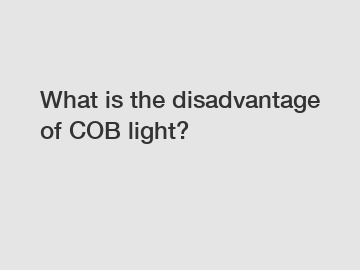Jan. 30, 2024
Lights & Lighting
What is the disadvantage of COB light?
COB (Chip-On-Board) technology has been rapidly adopted in the lighting industry for its numerous advantages. However, it is essential to understand the potential drawbacks of this technology. The primary disadvantage of COB light is its limited heat dissipation capability, which can result in decreased lifespan and reduced efficiency.
Heat dissipation is a critical factor in ensuring optimal performance and longevity of LED lights. With COB technology, multiple LED chips are closely packed together on a single PCB (Printed Circuit Board) substrate, resulting in high power density. This proximity can lead to heat accumulation and inadequate dissipation, especially when used in high-power applications.

The compact design of COB lights can cause them to operate at higher temperatures than traditional LED lights, reducing their overall lifespan. Excessive heat can accelerate the degradation of the LED chips, leading to color shifting, reduced brightness, and eventual failure. Moreover, the elevated temperature can affect the stability and reliability of other components, such as the driver and bonding wires.
To mitigate the heat dissipation issue, effective heat sink systems must be employed. Manufacturers often incorporate additional heat sinks, thermal pads, or cooling fans to maintain the COB light's temperature within an optimal range. However, these supplementary measures increase the size and complexity of the lighting fixture, which may not always be feasible or desirable.
The challenge of heat dissipation in COB lights has led to ongoing research and advancements in thermal management techniques. Innovations include the development of advanced materials with higher thermal conductivity, improved heat sink designs, and optimized thermal pathways. These advancements aim to enhance the heat dissipation capability of COB lights, reducing the impact of high temperatures on their performance and lifespan.
Despite this disadvantage, COB lights still offer compelling benefits. Their high-power density allows for increased lumen output, making them suitable for applications that require bright and focused lighting. The compact size of COB lights also enables more design flexibility, making them popular for various lighting fixtures, including track lights and downlights.
In conclusion, the limited heat dissipation capability is a notable disadvantage of COB light technology. The close packing of LED chips in COB lights can result in higher operating temperatures, reducing their lifespan and overall efficiency. However, through ongoing research and development, manufacturers are continuously improving the heat dissipation capabilities of COB lights. The benefits of COB technology, such as high lumen output and design flexibility, remain compelling, making it a promising solution for various lighting applications.
Contact us to discuss your requirements of smd led module, cob led chip 5w, Led Ra 98. Our experienced sales team can help you identify the options that best suit your needs.
If you are interested in sending in a Guest Blogger Submission,welcome to write for us!
All Comments ( 0 )